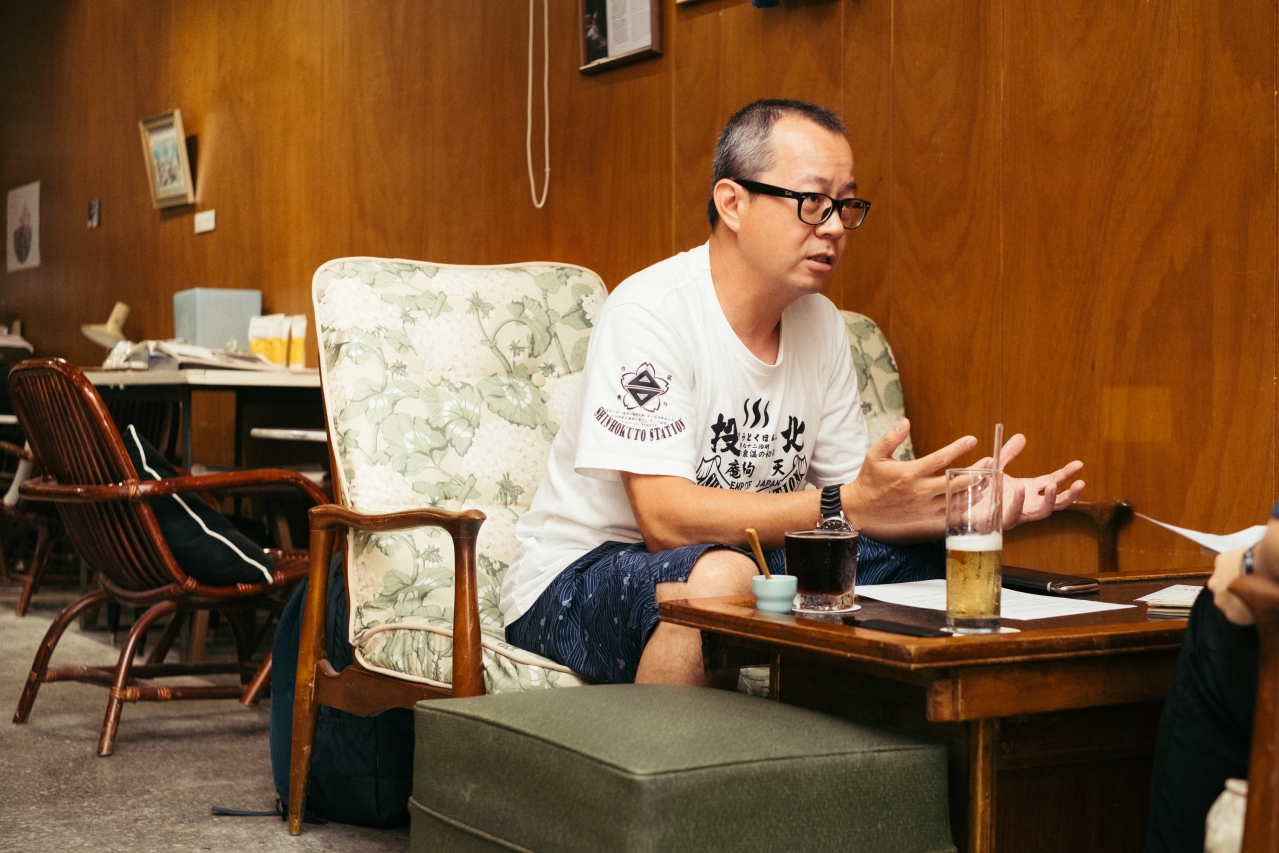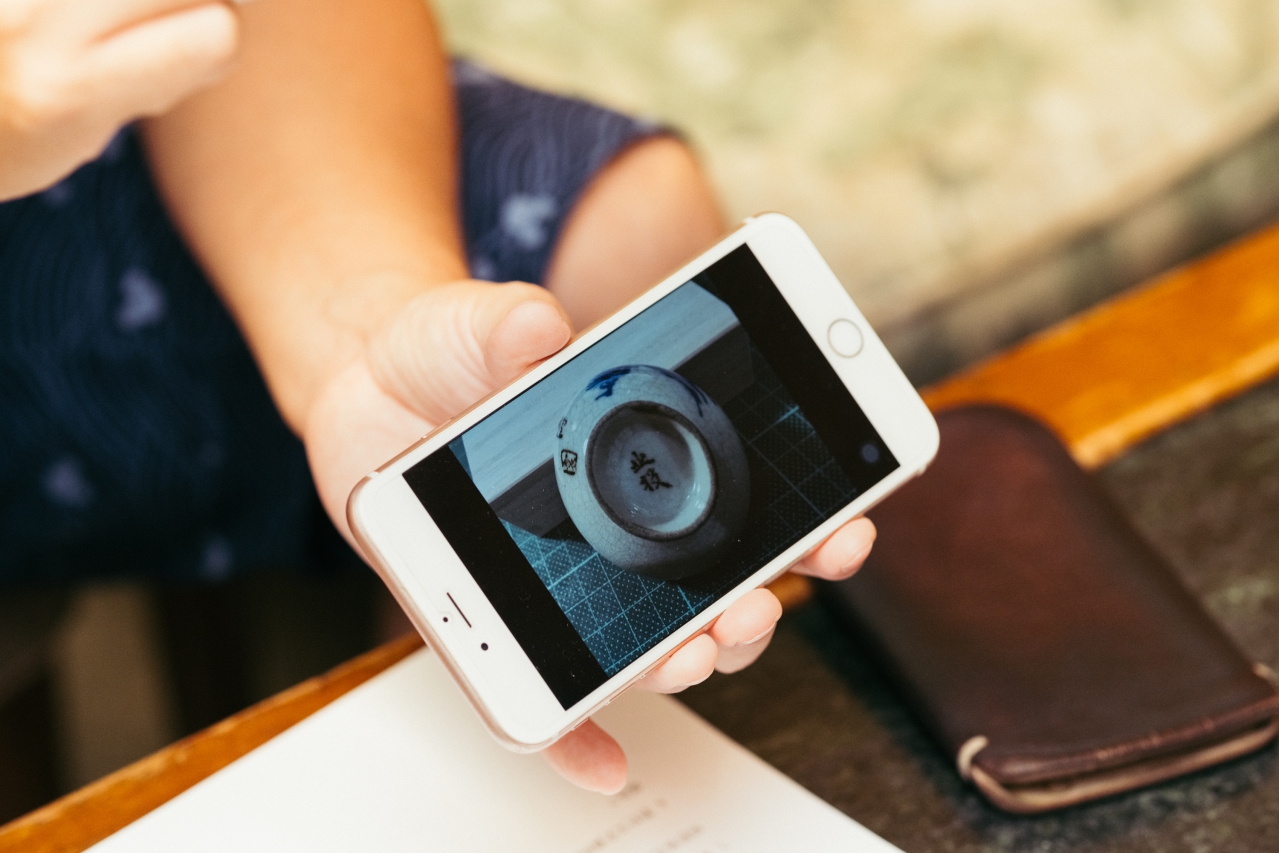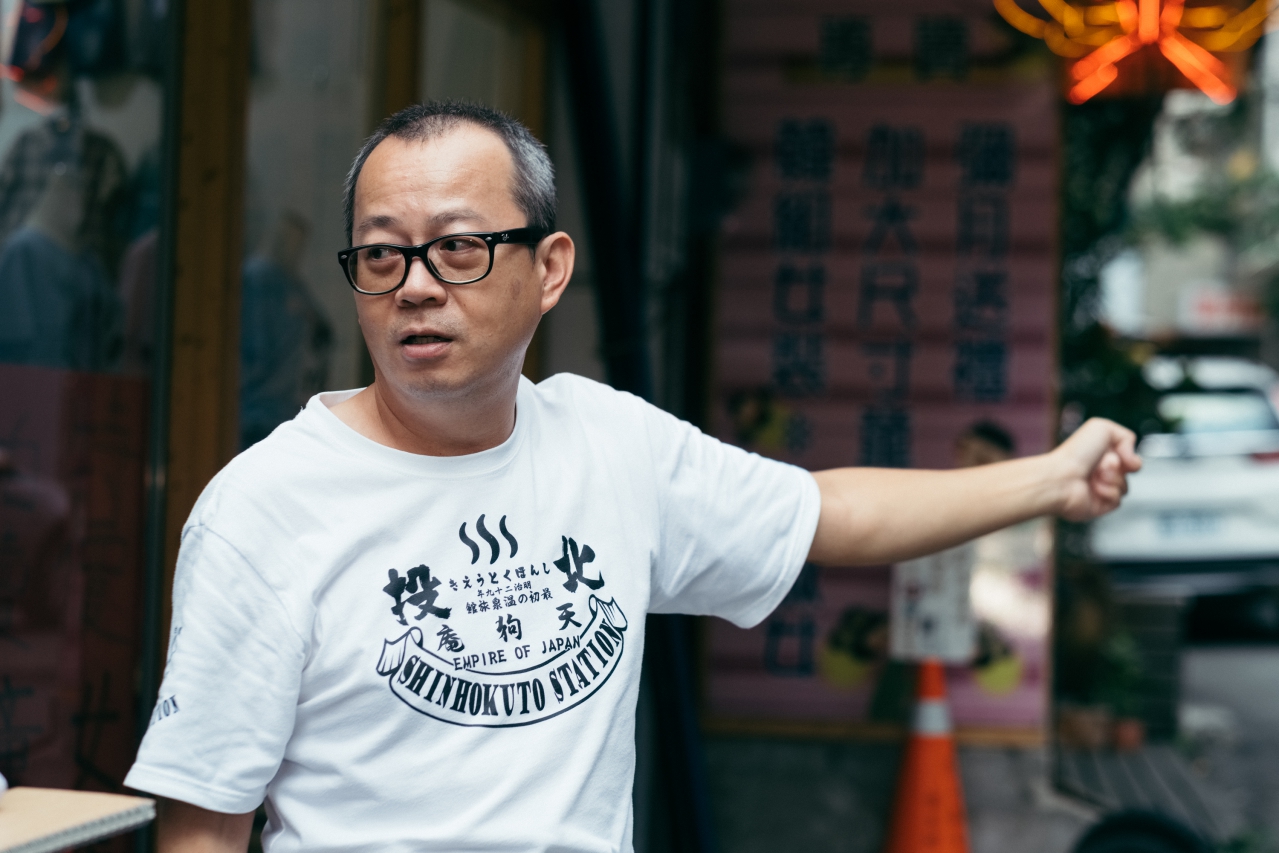As YANG Ye tells it, he only became used to people calling him a “cultural historian” in recent years, since he came from an unrelated professional background. Nevertheless, his love and persistence towards cultural history studies speaks for itself. How he got here then is probably not a particularly unique story. Born and raised in Beitou, collecting and studying local objects has been his natural predilection.
YANG was born in the historical district of Dadaocheng in Taipei, moving to Beitou when he was 2 to 3 years old, and spent many years of his childhood there. A most memorable experience was visiting cultural sites around Taiwan with his parents, such as Fort San Domingo and Lungshan Temple. His father, a history buff himself, would take them on their motorbike to places and give lectures on their past. This unremarkable interaction in the family had sown a seed in his heart. “That was the start of my fascination with ‘History,’” he says.
Little did YANG think that his interest would become a career. He enjoys history and likes to draw, but lagged at school. His efforts in art class were not appreciated by the traditional teachers. After graduating from junior high school, he applied for the Department of Fine Arts at Fu-Hsin Trade and Arts School, but on the day of the exam he got the mumps and fainted. He was sent home and would not apply for another year. Meanwhile, he became a Samanera, a novice monastic, at Baiyun Temple in Xizhi and apprenticed with Master Guanghua, worshipping the Buddha 108 times a day under his dharma name “Jing Ye.” The Master noticed his interest in drawing and asked him to take a look at Utterances on Image-making and Iconometry of the Chinese Buddhist canon, which teaches ways of drawing images of the Buddha. In this way he learned the method of drawing the Buddha in the prescribed dimensions and perspectives while practicing Buddhism. A year later as the day of the entrance exam drew near, the Master wanted him to continue his studies, so he was secularized.
Accepted into Fu-Hsin Trade and Arts School, YANG worked at factories and fell in love before graduating, like any typical student. He began his cultural history studies in 1993, after completing mandatory military service and starting work at the Niuer Stone Carving Park in Puli. He sought out rural villages, chatting with the elders there. The first place he chose was Xianxi Township in Changhua County because it was the homeplace of his mother’s foster father. He met with his grandfather’s younger brother who lived in the same house. From him, he learned about his grandfather, who died at a young age, had enlisted as a Japanese soldier, was sent to war overseas, and returned to Taiwan to take up a job at Changhua Bank. It was like a history tour of the family’s memories. He went on to other places around Changhua and Puli, where most able young men left town, leaving behind the old aged people and the children. His enthusiasm for interviewing was met with a warm welcome from the local residents.
“Back in those days, there were lots of Japanese era buildings and household implements in Taiwan, which I always found attractive. When the elders realized my enthusiasm for the stuff, they offered it to me as a gift, and of course, I was too afraid to accept. Now I think of it, how naïve was I to have refused! I wished I had accepted a few!” he says jokingly.
Though he did not accept the elders’ offerings, he was able to accrue vast amounts of recordings and video footage. These documents lacked a platform for publication and would not pass for professional or rigorous field research, but they are important for the passion they ignited in his heart. He redoubled his efforts, even considering a survey of all townships and districts of Taiwan, but soon realizing it would not be feasible. In the end, he limited his studies to his native Beitou. Thus he officially becomes Beitou’s “unofficial” cultural historian.

Delving into YANG’s work in Beitou, one finds several distinct aspects. First is a continuation of his past rural surveys and visits. Even while working in Puli, he would sometimes return to Beitou to conduct interviews and collect historical documents or records. His efforts only intensified after moving back to Beitou full time in 2003.
Now he lives in his hometown, where has been called Xinbeitou nowadays. Since that’s where the Japanese first planned their infrastructure, it is the most meticulously documented place in text and photographs. Though there’s no lack of published research in this area, they were usually written with an outsider’s view of “the other,” analyzing the changes over time, and did not convey a “feeling of everyday life.” Readers stand to gain only an idea of the “others’ Beitou.” For YANG, a timeline-based discussion of Beitou River tributary and environmental milestones is less meaningful than for example an appreciation of the beauty of the Japanese-built Chihsing and Datun Bridges. Rather than discussing how the hot springs industry has brought prosperity and joy to the adult population, he prefers to reminisce about the precious childhood days when Beitou River became a playground for the kids, who hopped across sandbanks and slung mud balls shaped from the sediments. While parents work, children would play. Milk caps were a favorite game, but the private adventure of kids in Beitou was to explore nearby Guizikeng and collect colored scrapped tiles from the kiln. They also tried their luck at the “mystery egg factory” next to Fuxing Park, to see if they can pick up any scrapped toys from the production lines. “Mystery egg” is an early version of the capsule toys. If you had some pocket change, you inserted some coins in the slot, pressed a button, the music flowed from the big machine, and a “mystery egg” landed in front of you. “The thing costs about as much as a bowl of misua, but what do kids know? Toys are more attractive than food!”
Besides YANG’s painstaking analysis of historical documents, there’s also his relentless collection of artifacts, in what can only be described as an “addiction.” Back when he sought out townships and districts while based in Puli, though he refused the gifts of the elders, he often hunted for treasured items at the curio shop on Changnan Road in Changhua County. He was able to amass such a collection that the Provincial Documents Committee of Taiwan tracked him down and bought out his acquisitions.
Nor did he leave any stone unturned back in Beitou. Focusing on photographic material, he wanted to piece together the changing landscape of Xinbeitou through imagery. The hot springs industry was well established, but no one knew what the first hot spring hotels looked like, as few photographs remain. So YANG made frequent rounds to the paper recycling yard, buying up whatever stacks of old photographs he can lay his hands on at low prices and eventually visiting flea markets all over Taiwan in his search. Gradually shop owners and peddlers have come to know the story of the “Beitou freak” who traveled great distances to tirelessly collect all artifacts related to Beitou. One time in Kaohsiung, he came across a deeply coveted batch of old photographs. The proprietor refused to sell, boasting that “he is saving the lot for the ‘Beitou freak,’ who’d pay anything he’d ask. He didn’t know I’m the guy he just talked about!” he says self-deprecatingly, wondering if his dedication has brought deceit, that anyone thinks they could have him fleeced.
Collecting artifacts relies on hard work, good connections, a deep pocketbook, and most of all, chance. Always with a soft spot for the genuine articles, YANG had heard about “Beitou-yaki” for years while doing research. His chance to own one came only in 2019. It is a wine cup measuring barely a palm’s width in diameter, with a luster of jade and fine hand-painting on the inside. A small vessel with a big story, Beitou-yaki was made at the Beitou Pottery Factory, established by the owner of the first hot spring hotel in Taiwan, the Songtaoyuan Hotel. The kiln later became known as Beitou Ceramics Co., Ltd., and continued to produce Beitou-yaki in a slight variation. During the Beitou Pottery Factory period, the Kanji characters for “Beitou” would be written in black calligraphy before it is fired. The Beitou-yaki of the Beitou Ceramics Co., Ltd. period would not feature any such characters. YANG’s was of the former kind, and not only carries the inscription for “Beitou,” but also the characters for the Songtaoyuan Hotel and was hand-painted on the inside. It is a gem by any measure. No more than 20 pieces of these rare artifacts exist today in Taiwan, and to be able to buy one from a friend makes him extremely happy.
 A chance of a lifetime purchase, YANG’s own Beitou-yaki wine cup was produced at the Beitou Pottery Factory, which was established by the owner of the Songtaoyuan Hotel, the first hot spring hotel in Taiwan. The bottom of the cup is inscribed with characters of “Beitou” in black ink calligraphy. Photo by CHU Chi-Hung © C-LAB
A chance of a lifetime purchase, YANG’s own Beitou-yaki wine cup was produced at the Beitou Pottery Factory, which was established by the owner of the Songtaoyuan Hotel, the first hot spring hotel in Taiwan. The bottom of the cup is inscribed with characters of “Beitou” in black ink calligraphy. Photo by CHU Chi-Hung © C-LAB
Reciprocating by sharing what he finds, YANG’s cultural history studies promptly grew in momentum and scope. But sharing does not necessarily mean opening an exhibition. Through his drawings and talks, the uniqueness of Beitou is widely disseminated.
Specializing in illustrations, YANG was once commissioned to produce a 2 by 1.6 square meter (6.6 by 5.2 square feet) guide map for the Nantou County Cultural Center. It was well-received, and YANG began receiving similar requests to produce maps for other municipalities. His Beitou bird’s eye pictorial map was exhibited in 2012 at the Beitou Hot Spring Museum and furthermore included in the National Science Council’s Cyber Island Digital Collection. He surveys each place in person, reads into the development and change of society, and renders it in an artistic style reminiscent of Japanese ukiyo-e art. His reputation as the “hand-drawn map expert” is beyond dispute.
As for talks, they take the form of a guided tour. He collaborates with cultural history groups such as Beitou Storyteller and takes groups on sightseeing tours around Beitou, covering religious sites in addition to the requisite hot spring locations. He believes that temples, such as Puji Temple and Taipei Municipal Heritage Site Shingon Buddhism Grottoes, are the highlights of Beitou. He would make sure they are part of the itinerary even if the tourists would have to a hike up the hill to arrive the sites. He carefully notes the structures perched along the hillside, the golden ornaments at the corner windows and the dougong structure, and the insignias at the end of the roof tiles which signify the denomination of a particular temple. Features such as Puji Temple’s turtle-shaped reliefs on the ornamental roof tiles might reveal a possible relationship to the protector god of the north, Xuanwu.
 Often invited to give street tours in Beitou, YANG believes that the highlights most worthy of seeing in Beitou are not its hot springs, but its many temples. Photo by CHU Chi-Hung © C-LAB
Often invited to give street tours in Beitou, YANG believes that the highlights most worthy of seeing in Beitou are not its hot springs, but its many temples. Photo by CHU Chi-Hung © C-LAB
YANG’s routine for the past two years has been mountain-climbing because he found that many historic trails in Taiwan are accompanied by Japanese-era police posts, and the Japanese left behind many utensils such as wine bottles. “I acquired a lot of hotel receipts from Japanese era hot spring hotels. The Japanese ordered food and drinks, but there were no utensils preserved. Whenever I learn of their existence in the mountains, I would track them down tirelessly. I must have collected over 50 different bottles!” For example, the store Suzuki Shoten, also presented in the film Oiesan starring famed Japanese actress AMAMI Yuki, grew fortunes with the camphor trade, and had opened a Beitou store which sold the Sakura beer brewed by Teikoku Brewery Company Limited. It comes in a bottle which features a cherry blossom totem with a simple Kanji character “emperor,” fully reflective of its historical context. At the Haishu Mountain at Hualien’s Taroko Gorge, he also found fire-retardant bricks made at the previously mentioned Beitou kilns. Those mountains are a treasure box, providing him with new surprises on every visit.
Always enthusiastic to take to the mountains in search of the next artifact, YANG Ye has devoted 30 odd years to his line of cultural history studies, making it his life’s work. Though he did not come from the same field of expertise, never became rich, and is no stranger to time and effort spent on the seemingly meaningless chase, he enjoys the work enough to keep doing it. Come to think of it, maybe it has something to do with his teenage experience as a monastic, being devoted to his life’s work in Sadhana, with no need to expound to outsiders. History is silent, so the road must be quiet. But if the mind is clear as a mirror, the heart is at ease, leaving no place for worry.